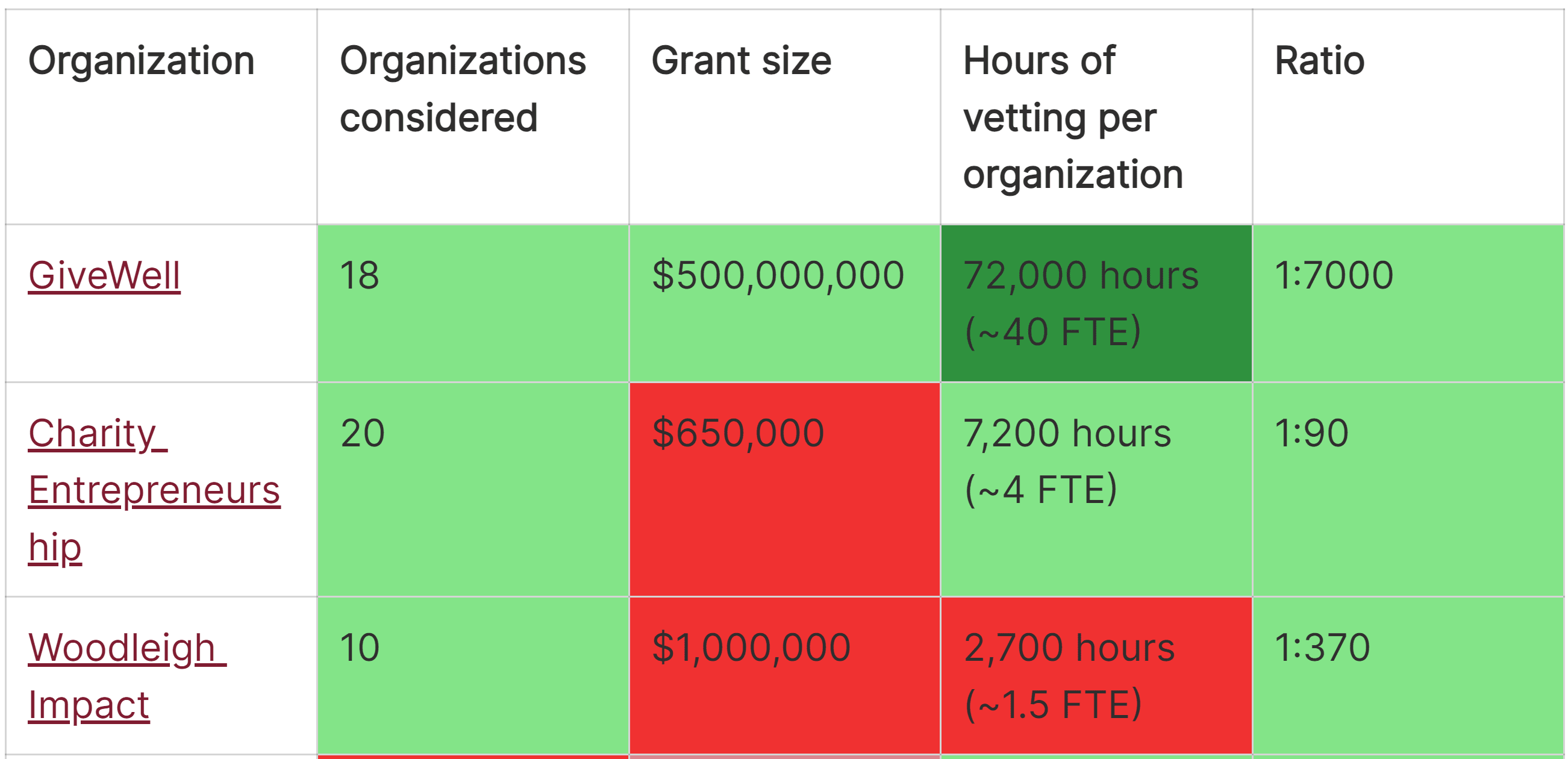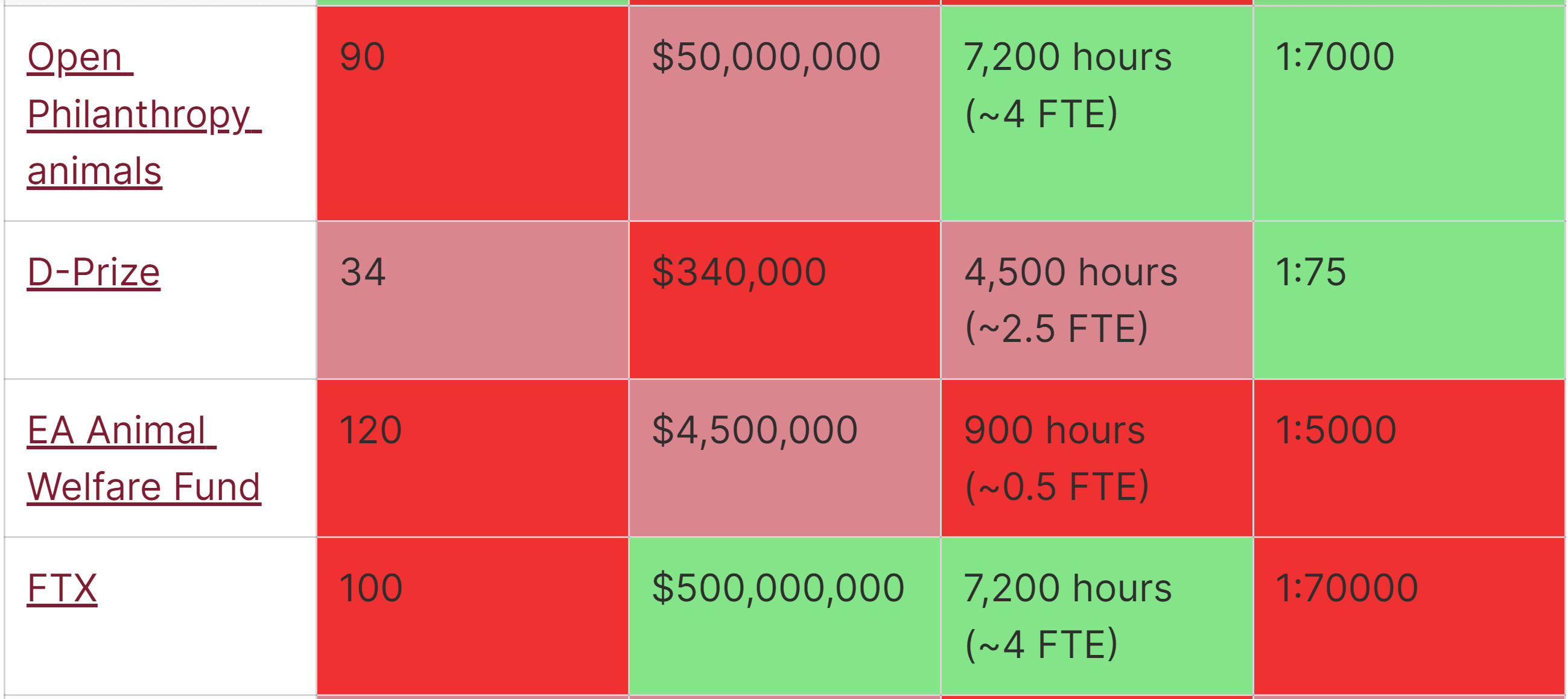On 17 February 2024, the mean length of the main text of the write-ups of Open Philanthropy’s largest grants in each of its 30 focus areas was only 2.50 paragraphs, whereas the mean amount was 14.2 M 2022-$[1]. For 23 of the 30 largest grants, it was just 1 paragraph. The calculations and information about the grants is in this Sheet.
Should the main text of the write-ups of Open Philanthropy’s large grants (e.g. at least 1 M$) be longer than 1 paragraph? I think greater reasoning transparency would be good, so I would like it if Open Philanthropy had longer write-ups.
In terms of other grantmakers aligned with effective altruism[2]:
- Charity Entrepreneurship (CE) produces an in-depth report for each organisation it incubates (see CE’s research).
- Effective Altruism Funds has write-ups of 1 sentence for the vast majority of the grants of its 4 funds.
- Founders Pledge has write-ups of 1 sentence for the vast majority of the grants of its 4 funds.
- Future of Life Institute’s grants have write-ups roughly as long as Open Philanthropy.
- Longview Philanthropy’s grants have write-ups roughly as long as Open Philanthropy.
- Manifund's grants have write-ups (comments) of a few paragraphs.
- Survival and Flourishing Fund has write-ups of a few words for the vast majority of its grants.
I encourage all of the above except for CE to have longer write-ups. I focussed on Open Philanthropy in this post given it accounts for the vast majority of the grants aligned with effective altruism.
Some context:
- Holden Karnofsky posted about how Open Philanthropy was thinking about openness and information sharing in 2016.
- There was a discussion in early 2023 about whether Open Philanthropy should share a ranking of grants it produced then.
- ^
Open Philanthropy has 17 broad focus areas, 9 under global health and wellbeing, 4 under global catastrophic risks (GCRs), and 4 under other areas. However, its grants are associated with 30 areas.
I define main text as that besides headings, and not including paragraphs of the type:
- “Grant investigator: [name]”.
- “This page was reviewed but not written by the grant investigator. [Organisation] staff also reviewed this page prior to publication”.
- “This follows our [dates with links to previous grants to the organisation] support, and falls within our focus area of [area]”.
- “The grant amount was updated in [date(s)]”.
- “See [organisation's] page on this grant for more details”.
- “This grant is part of our Regranting Challenge. See the Regranting Challenge website for more details on this grant”.
- “This is a discretionary grant”.
I count lists of bullets as 1 paragraph.
- ^
The grantmakers are ordered alphabetically.




(I work at EA Funds)
These seem like pretty unreasonable comparisons unless I'm missing something. Like entirely different orders of magnitude. For context, Long-Term Future Fund (which is one of 4 EA Funds) gives out about 200 grants a year.
If I understand your sources correctly, CE's produces like 4 in-depth reports a cycle (and I think they have 1-2 cycles a year)? So 4-8 grants/year[1]
I would guess that EA Funds gives out more grants (total number, not dollar amount) than all the other orgs in your list combined except OP[2].
Of course it's a lot easier to write in-depth reports of 8 grants than for 400! Like you could write a report every month and still have some time left over to proofread. [3]
I think they also have more employees.
I'm more confident if you exclude SFF, which incidentally also probably gives out more grants than all the other orgs combined on this list if you exclude OP and EA Funds.
When LTFF "only" gave out 27 grants in a cycle, they were able to write pretty detailed reasoning for each of their grants.
Right, but they have not been doing it. So I assume EA Funds would have to at least encourage applicants to do it, or even make it a requirement for most applications. There can be confidential information in some applications, but, as you said below, applicants do not have to share everything in their public version.
I guess the opposite, but I do not know. I am mostly in favour of experimenting with a few applications, and then deciding whether to stop or scale up.